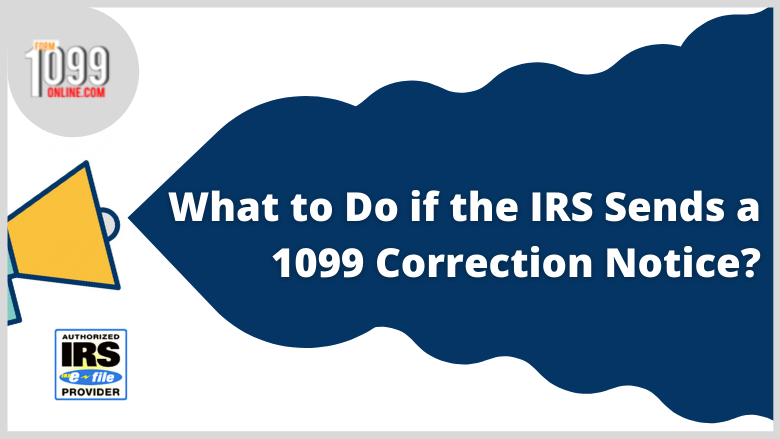Did you receive an unexpected notice from the IRS? Does the notice indicate to start backup withholding taxes? The IRS sends a 1099 correction notice to the payers to correct the error and to start back up withholding taxes from the payee.
Getting confused? Don’t worry! We will let you know what to do if the IRS sends a 1099 Form correction notice. We will explain the notice you received in detail by providing simple steps you’re responsible for after receiving a correction notice.
Table of Contents
- What are the reasons behind the 1099 Correction Notice?
- 1099 Correction B notice
- What are the payments subject to backup withholding?
- When is a TIN considered missing or incorrect?
- When do you send a B notice to a payee?

What are the reasons behind the 1099 Correction Notice?
Each year the IRS sends out B notices to the payers in the form of CP2100 and CP2100A. These notices create a significant burden to the payer who files a 1099 Tax Form. CP2100 or CP2100A notice tells that the payer responsible to withhold taxes under backup withholding rules. Generally, the IRS issued this notice when the payee’s TIN is missing, incorrect, or invalid. Filers who submit more than 250 information returns receive CP2100 notice. Other filers who submit fewer than 1099 Tax Forms less than 250 receive CP2100A notice.
What is a 1099 Correction B notice?
“B” notice is referred to as backup withholding notice. It creates potentially backup withholding taxes, incorrect filing penalties, and IRS Form 1099 audit. The IRS sends B notices to the 1099 filers who have submitted mismatching names and TIN combinations. Essentially, every business owner who reports 1099 information returns in excess eventually receives a B notice. This may be due to events beyond their control. For instance, if the payee changes their Taxpayer Identification Number name and not notifies the payer.
There are two kinds of B notices. The payee sends the first B notice to the payee along with the W-9 Form after receiving the first CP2100 or CP2100A for soliciting the correct TIN. Second B notice must be sent to the payee after receiving the second CP2100A or CP2100 notice within 3 years period. The second B notice indicates that the payee must contact the IRS to obtain the correct name/TIN combination.
What are the payments subject to backup withholding?
Following are the payments subject to backup withholding:
- Rents, royalties, gross proceeds paid to attorneys, determinable gains, profits, or income reportable on Form 1099 MISC.
- Interest income reportable on 1099 INT, and dividend income reported on Form 1099 DIV.
- Payment card and third-party network transactions reported on 1099 K.
Payments excluded from backup withholding include:
- Real estate transactions, foreclosures, and abandonment.
- Canceled debts, distributions from Medical Savings Accounts, long-term care benefits.
- Distributions from any retirement accounts, employee stock ownership plan, fish purchases for cash.
- Unemployment compensation, state or local income tax refunds, qualified tuition plans, etc.
When is a TIN considered missing or incorrect?
TIN is a nine-digit numeric code assigned to the individual to track tax obligations as per the IRS guidelines. It may be an Employer Identification Number, Social Security Number. A TIN is considered to be missing if:
- It has more or less than nine digits.
- Anyone digit consists of alpha characters.
- It is not provided.
Example of incorrect or missing TINs:
Missing SSN: 123-45-678/;
In the above example, the last digit in the SSN missing. Correct SSN will be 123-45-6789 format.
Missing EIN:12-345678p;
In the above example, the last digit in the EIN is “missing”. Correct EIN will be “12-3456789”.
Incorrect TIN: If the name/TIN doesn’t match with the IRS database.
When do you send a B notice to a payee?
You need to send a B notice to the payee within 15 business days from the CP2100 or CP2100A Notice date. In general, you don’t have to send a B notice to the same payee more than two times in three calendar years. Furthermore, if you’re sending a second B notice to the payee, make sure not to include W-9 Form. As mentioned earlier, the payees must identify the difference between the first B notice and the second B notice. The payee is responsible to provide the correct TIN with name matching in the IRS database. Otherwise, the payer can start backup withholding of 24% from certain payments. Failure to follow backup withholding rules results in penalties to the payer.
Mistakes are common when you file Form 1099 at the last minute. Form1099Online provides instant audit checks to eliminate last-minute filing errors. Create a free e-file account today with us and e-file 1099 Tax forms in minutes.
